 I wanted to try scratch building some tree armatures for wargaming. Two main reasons, one I wanted to see how hard it would be and two I’ve always been pretty disappointed with the way paper trees look, the paper trees are normally to short and/or have that toilet paper tube look. I think in the case of trees paper may not be the best medium. Below is a bit of a how to on what I did to make my trees. I’ve only done single trunk trees however I am going to try multi-trunk and fruit trees later on. I apologies for the below pictures but it was very difficult to take some decent photos to show the build process. You can see some further photos of the textured trunk at the end of this blog post. The information contained below I’ve picked up in various forums, tutorials and by looking at some commercially available trees over the past decade or so, unfortunately this means I can’t provide any links to anyone place as inspiration, think of the below as an amalgamation of web idea’s plus some of my own all mixed together.
I wanted to try scratch building some tree armatures for wargaming. Two main reasons, one I wanted to see how hard it would be and two I’ve always been pretty disappointed with the way paper trees look, the paper trees are normally to short and/or have that toilet paper tube look. I think in the case of trees paper may not be the best medium. Below is a bit of a how to on what I did to make my trees. I’ve only done single trunk trees however I am going to try multi-trunk and fruit trees later on. I apologies for the below pictures but it was very difficult to take some decent photos to show the build process. You can see some further photos of the textured trunk at the end of this blog post. The information contained below I’ve picked up in various forums, tutorials and by looking at some commercially available trees over the past decade or so, unfortunately this means I can’t provide any links to anyone place as inspiration, think of the below as an amalgamation of web idea’s plus some of my own all mixed together.
You will need to gather some supplies before you can start making trees:
- Acrylic Gap Filler (White cheaper, Brown can save painting)
- 20-30 meters of 1.57mm diameter (14-15 gauge) galvanized tie wire
- 20-30 meters of .9 mm diameter (19 gauge) galvanized tie wire
- Coarse art paint brush
- Wire Cutters
- Long nosed pliers
- Hot Glue Gun and/or PVA glue
- Masking tape 18mm / 3/4 of an inch
- Disc magnets 15mm x 1mm/ 5/8 x 1/32 inch(optional)
- 5 min epoxy if your using the magnets and don’t have hot glue
- Super glue
- Strong fingers 🙂
If you can’t find the exact tie wire listed above slightly thinner would be better than slightly thicker, make sure it is tie wire and not high tensile fencing wire. In Australia you can get all the above items from your local hardware store, except for the magnets, the magnets I used are these magnets available from deal extreme. Deal extreme also sells an 18mm x 2mm magnet which would be interesting to experiment with.
 Some of the tools
Some of the tools
The dimensions etc listed below will make a tree approximately 20cm/8inches tall, at the end I’ve included some dimensions and lengths for a 6inch tall tree. You should be able to expand this method out to make taller trees by simply adding an extra longer length. The first step is to grab your thicker (1.57mm) tie wire and cut some lengths of wire:
- 4 x 12.5cm / 5 inches (potentially optional read below)
- 4 x 20 cm / 8 inches
- 4 x 26.5cm / 10.5 inches
- 4 x 30cm / 12 inches
 Wire Lengths
Wire Lengths
Grab two of the same length of wire and twist them together using your fingers and the pliers. Make sure you leave a tail at the end being held by the pliers of about 1.5cm / 3/4 of an inch, later these will become the roots of the tree. Do not twist the wires all the way together leave at least 4cm / 1.5 inches untwisted on each piece. I’ve done a picture and a very short video to try and show what I mean.

Link To Video
For the 5inch lengths there is no need to leave a tail on them as they will be used as extra branches, hopefully you have two of each twisted length something similar to the below.

Twisted wire pairs
Similar to the above process now grab two of the same length twisted wire pairs and twist them together. This is harder to do due the 4 strands of wire, if you need to you can use a second pair of pliers to help with the twisting. Again do not twist the wire pairs all the way together as the end part of the wire becomes the branches. As a rough guide leave at least 10cm / 4inches on the 20cm / 8inch wire pairs, 8cm /3 inches on the 26.5cm / 10.5 inches wire pairs and 6cm / 2 1/2 inches on the 30cm / 12 inches wire pairs. There is no need to twist the two 12.5cm / 5 inch lengths together as these are used later independently.

Now the fun part begins, you need to shape your wire pairs into some semblance of the start of a tree trunk and branches. Basically you just need to bend the untwisted wire parts down, not as far down as 90 degrees but just slightly sloping upwards, try not to bend the two branches exactly opposite each other, stagger one slightly up and the other slightly down. I’ve included a diagram below which shows the approximate lengths to leave prior to doing a bend, don’t take these figures as 100% accurate but use them as a starting guide and then if something looks off adjust it a little. You may end up with a little extra wire at the ends if you do just snip it off, likewise if one branch is turning out a little short don’t worry to much trees don’t seem to when they grow in nature :). Bend your short root ends up at about 90 degrees.
 Click to enlarge picture
Click to enlarge picture
Hopefully you now have five parts that look something like the below.
 Wire pairs twisted together
Wire pairs twisted together
This next part is difficult to describe, however hopefully with my description and the pictures below you’ll be able to work out what I mean. Take your Short, Medium and Long trunk/branch segments and fit them together so that the roots at the bottom are lined up flat but pointing out in different directions and the branches poke out in different directions at the top or as different as you can get them. Next take a short length (8-10cm, 3-4 inches) of masking tape and tape the very bottom of your tree just above the roots, tape as tightly with the masking tape as you can to help hold the three wire pieces together. The three wire trunks will naturally form a sort of triangle down the bottom.

You can really start to see the tree in your wire armature now. To help strength the tree further and hold it together, You will need to wrap masking tape tightly around the trunk under each wire branch pair.
 Masking tape around trunk below branches
Masking tape around trunk below branches
Your tree should be fairly sturdy now and is hopefully not in any danger of falling back into it’s component parts. However to really help tie the wire together in a more permanent structure. Grab your hot glue gun/ PVA glue and in the gap between your base masking tape and your first branch piece of masking tape push some hot glue or PVA glue into this gap. The advantage with hot glue is that it dries quickly so less waiting around. The below image shows were you should have the glue placed, feel free to use your hot glue on other spots if you feel the armature needs it.

If you like you can stop there and call your tree miniature armature done and not worry about adding a few extra branches. I’ve done a few trees with just opposite branches and it does have some advantages, you use less Acrylic gap filler, less branches means less “leaf” (ok sponge material) that you have to glue and use on the tree, quicker to paint and most importantly the trees will still look good. If you do wish to use the two extra branches they are pretty easy to use, basically bend what would be the root end down about 1.5cm / 1/2 inch. Select a location for your branch and size it to about the same length as the other two branches located near it. You want your branches to be evenly spaced around your tree so you will need to bend the other two like sized branches back towards each other ie the angle between your three complimentary sized branches will be approximately 120 degrees. Now using your hot glue gun glue the branch to the side of your tree. While the hot glue is drying wrap some masking tape around the tree trunk and the branch tail to help hold it in place (the tape is very important if you use PVA glue). Unfortunately I couldn’t get a picture of myself covered in strands of hot glue and wincing in pain as it stuck to my hands, but hopefully the two pictures below and the description above give you a rough idea of what to do.
 Deciding on position
Deciding on position

All Glued and Taped in place
Once you have your branches added on, next is to add a short top to the tree. I use the 0.9mm wire and just twiddle a bit around the the top of the trunk and extend it upwards about 3.75 cm / 1.5 inches and then have small branches pulled down on each side of about the same length (you may need to glue/tape it in place). I’ve circled the topper in blue in the below photo and the extra branches in red.
 Extra branches and topper
Extra branches and topper
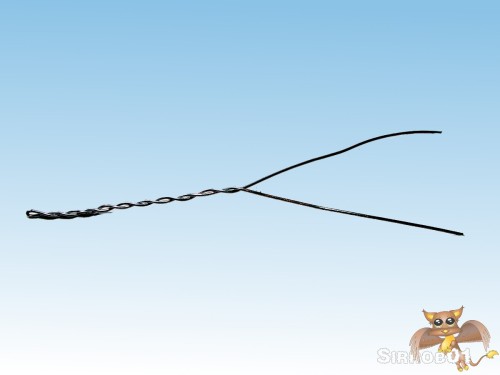 Topper ready for use
Topper ready for use
I’ve put magnets in to the base of my tree so that they magnetize down onto the terrain to help stabilize the trees when they are being used during gaming but can be easily lifted out of the way if needed. I’ll need to do a post later on detailing how I make my hills etc with grab points. If you prefer to permanently affix your trees to your terrain you can skip this step. If you look at the base of your tree you’ll notice the roots are all crisscrossed over one and other, what you want to do is untwist and pull these out flat. The picture below shows a base I’ve sorted and flattened out. You want your root ends at this point to be pointing slightly upwards (Yes my roots are slightly longer than needed).

Take two of your 15mm magnets and super glue them together, next temporarily stick your magnets to the base of the tree and stand the tree on a flat surface check in all dimensions that the tree trunk is approximately vertical and isn’t laying over in one direction or the other. If the tree trunk is laying over re-bend your roots to help flatten it out. If it looks good simply hot glue or epoxy glue the magnets in place.

Next trim your roots to the length about 18mm / 1/2 an inch long. Once they are all trimmed down you want to bend the roots down so that the tips of each root are level with the base of the magnet. I find the best way to do this is to bend them down to about where I think they need to be and then check them by standing the tree on a tabletop and bend any up and down that need adjusting. The roots will seem to curve down over the magnet which is the effect we are after. You can also see in the below picture were I built up the base with a bit of hot glue.
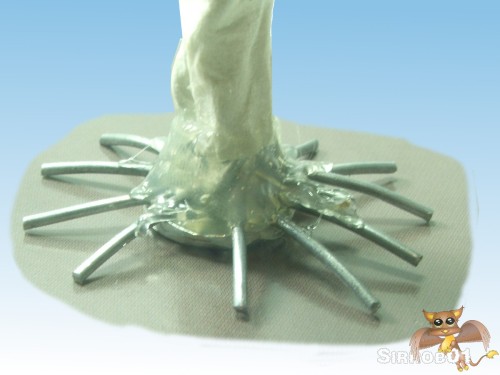
Lastly before we apply the acrylic you can further bandage the tree in masking tape. I have made trees with and without masking tape bandaging. A quick pro’s and con’s for bandaging:
Pros
|
Cons
|
| Use less acrylic filler |
Time taken to bandage tree in masking tape |
| Easier to cover the wire with filler |
|
| Quicker when using acrylic filler |
|
From the above it would appear the best thing to do is to masking tape the armatures however this does add significant time and is reasonably fiddly as I’ve had to cut the masking tape in half length wise to tape the branches. Saying that at the moment I do lean towards bandaging the trees in masking tape. If you do use masking tape make sure to try and respect basic tree anatomy, ie thinner towards the ends of branches and top of the tree. I also do a last pruning at this stage to check I don’t have any to long branches or branches pointing in the wrong direction, basically just try to give the tree reasonable symmetry. The two pictures below show a bandaged tree and an un-bandaged tree ready for painting with acrylic gap filler.
 Bandaged Tree
Bandaged Tree
 Un-Bandaged Tree
Un-Bandaged Tree
I tend to stockpile 5-6 armatures before I paint them with a coat or two of acrylic gap filler (If you want to permanently fix your trees to your terrain now is the time to glue them in position on the terrain). Take one of your armatures and put a drop of super glue onto the magnet on the underside and try to get a dot on the end of each root, now place the tree down on a piece of thin writing paper so the magnet and root tips glue to the paper, to get a good smooth bond use a metal surface (old computer case wall for example).

I find I get a better bark texture if I squeeze out some gap filler into a small bowl and then add a few drops of water and mix it in so the gap filler is slightly less goopy. The more water you add the smoother your bark will appear once the gap filler dries, this is a good way to show different types of tree barks. Next just grab your coarse paint brush (I use a cheap art 1/2 brush) and paint the gap filler onto the armature. When you brush the gap filler onto the armature brush the gap filler on the trunk in an up and down direction and paint a long the branches (red arrows). Try to build up a sort of triangular shaped wedge on the underside of the branches were they join the trunk (Green triangles), Don’t paint to much on the branch wire ends just a thin layer to cover the silver wire.

Painting Gap Filler Flow Diagram
Don’t worry to much if you think the texture looks wrong as you paint it on, even some really weird lumpy textures look very bark like when you get them dry brushed. Below I took are two pictures one shows a group of trees dried after being painted with brown acrylic gap filler and the second a close up of the base and bark texture.
 Four 8 inch trees and One 6 inch tree
Four 8 inch trees and One 6 inch tree
 Close up of base and bark texture
Close up of base and bark texture
Once the acrylic filler dries about 12-24 hours trim the base to a roundish circle using the wire root ends as a guide. Next paint the underside of the base with some PVA glue, don’t worry that the base is a little wrinkly, the important thing is that the magnet and the wire tips provide the contact points with the ground and these wont be wrinkly. After I’ve done the coat of PVA glue I then paint the the underside of the base black. You now have three options
- You can use the trees as is or
- Give the tree a quick dry brush with a lighter colour to bring out the ridges or
- Fully paint them with a mid colour, dark wash and a dry brush.
If you used white gap filler you’ll have to do a full paint or at least a base coat. I’ve been doing the last option as it really helps to bring out the texture of the bark and makes the tree look good on the table. My colour choices for bark have been burnt sienna as the base coat, darkened burnt umber as a wash and Bilious brown as the dry brush highlight. Below are a couple of pictures of a finished tree armature, in the below picture you can see were I’ve missed the dark brown wash in a few spots as the wood appears redder (most noticeable on branch tips which will eventually be covered in clumping foam).
 Single Tree Closeup
Single Tree Closeup
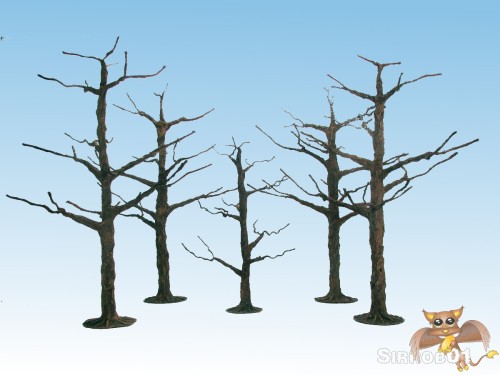 Group Shot Finished
Group Shot Finished
Last step is to just add your preferred type of tree leaf material. I’ve been using Woodland Scenics clumping foam stuck on with super glue so they are really durable for wargaming. There are a few ways of making your own tree leaf material but I’ve found the clumping foam to be the best compromise between cost and durability. The below finished tree isn’t one of the above but it is one of my first prototypes which I painted in a slightly different colour scheme, however as an unexpected bonus the colouring works better when photographed.
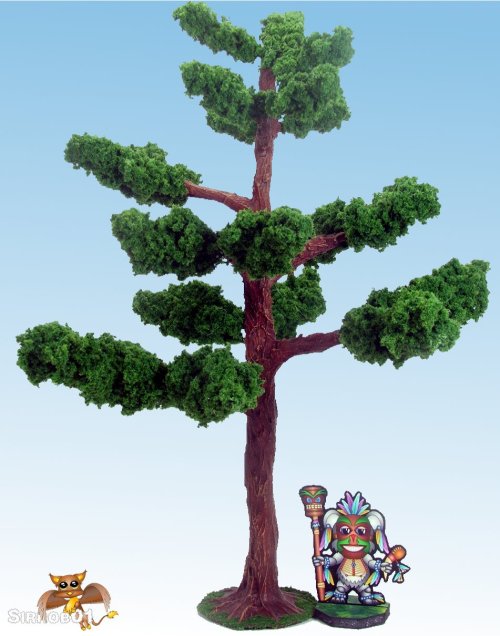
For a six inch tree you want to cut wire to the below lengths from .9 mm diameter (19 gauge) wire:
- 4 x 7.5cm / 3 inches (extra branches)
- 4 x 12.5 cm / 5 inches
- 4 x 17.5cm / 7 inches
- 4 x 22.5cm / 9 inches
Using those as a starting point you should be able to assemble a six inch high tree using the above guide and these wire lengths as a starting point. In the off chance someone would like to read this as a PDF later on I put one together available here (3mb).
Have fun with your trees 🙂
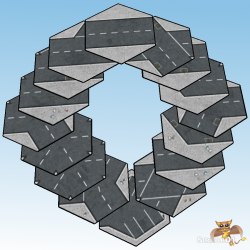 Now that we have power on our Battletech map-board we need some roads so people can move around and start to build the city…maybe I’ve played a little to much Simcity in my time. Some simple asphalt road tiles to spread around your map board to give it more of a city feel. Later I may do some transition tiles for cross-country roads so they meld better with a green background.
Now that we have power on our Battletech map-board we need some roads so people can move around and start to build the city…maybe I’ve played a little to much Simcity in my time. Some simple asphalt road tiles to spread around your map board to give it more of a city feel. Later I may do some transition tiles for cross-country roads so they meld better with a green background.















































